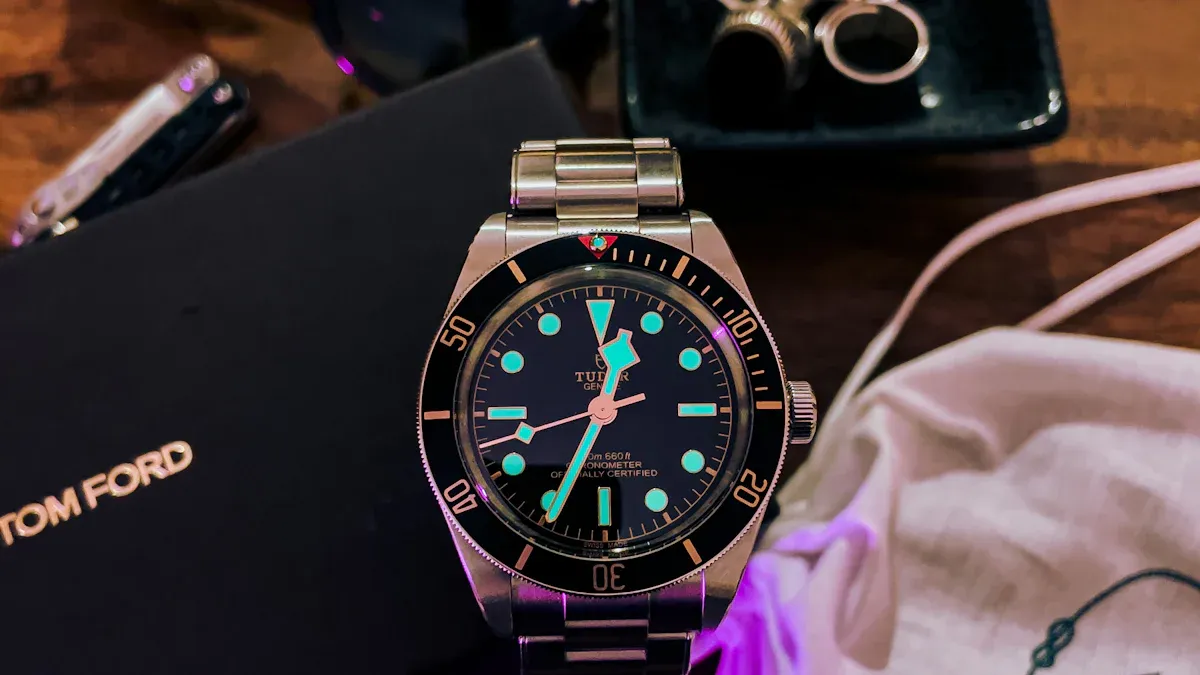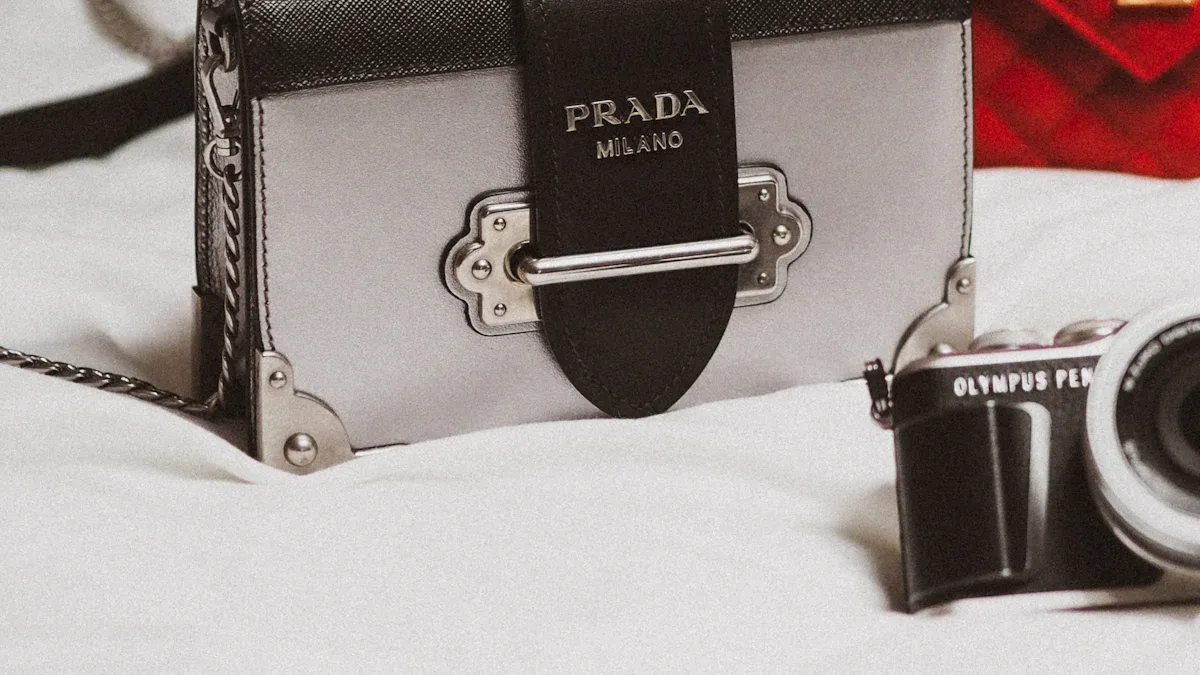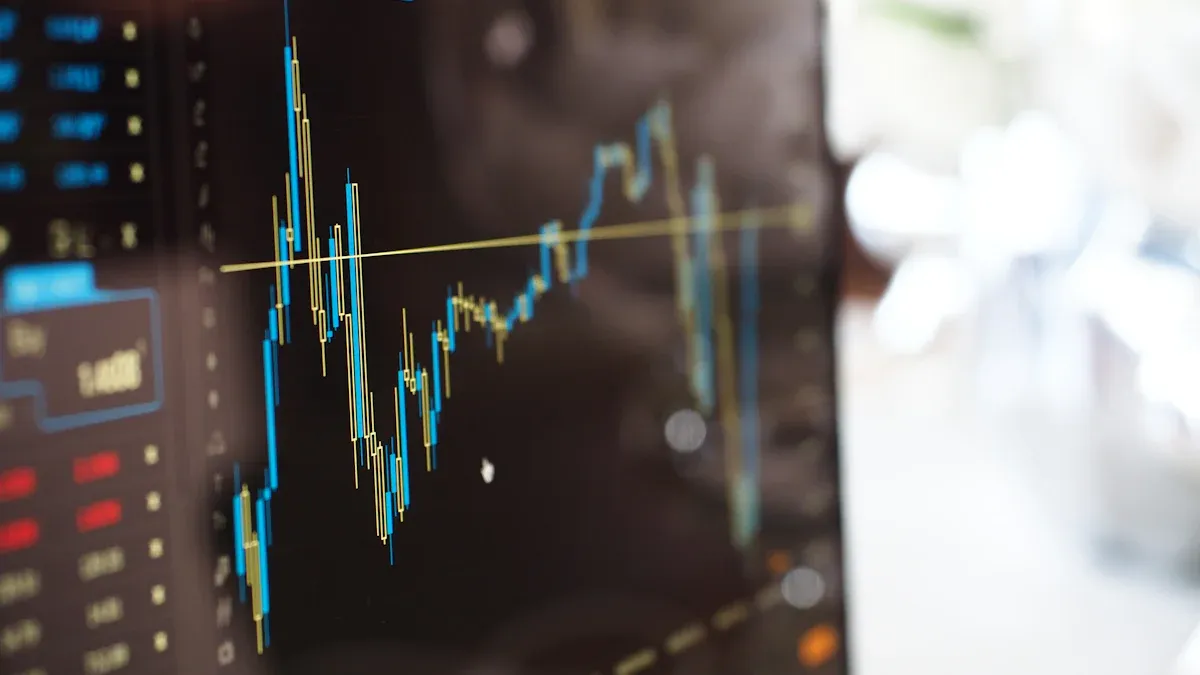Image Source: unsplash
Investors increasingly turn to alternative investment opportunities: the potential of art and luxury markets to navigate volatile markets and achieve portfolio diversification. The art and luxury markets offer unique potential for growth. Recent data reveals that 92% of advisors allocate to alternatives, with 91% planning to increase allocations. The collectibles sector alone could reach $484.6 billion by 2025, growing annually at 9.2%.
Key Takeaways
- Different investments, like art and fancy items, can help spread risk and protect money when markets drop.
- Buying art can make good money, as modern art often grows in value over time.
- Careful study and advice from experts are important to understand the tricky art and luxury markets.
Understanding Alternative Investment Opportunities
What Are Alternative Investments?
Alternative investments refer to asset classes that differ from traditional investments like stocks, bonds, and cash. These include private equity, hedge funds, real estate, commodities, art, and luxury goods. Unlike traditional assets, alternative investments often exhibit unique characteristics.
| Characteristic | Alternative Investments | Traditional Investments |
|---|---|---|
| Fees | Higher fees | Lower fees (mutual funds, ETFs) |
| Liquidity | Lower liquidity | Higher liquidity |
| Accessibility | High minimum investment requirements | More accessible to average investors |
| Regulatory Standards | Different regulatory standards | More standardized regulations |
| Transaction Costs | Lower transaction costs | Higher transaction costs |
| Valuation Difficulty | Harder to value due to unique nature | Easier to value with market data |
These investments often require higher minimum capital and specialized knowledge, making them less accessible to average investors. However, they offer opportunities for diversification and potential returns that traditional markets may not provide.
Why Alternative Investments Are Gaining Traction
The growing appeal of alternative investments stems from their ability to address challenges in traditional markets. Investors increasingly seek diversification and higher returns amidst market volatility. Private equity and hedge funds, for example, have become integral components of modern portfolios. Additionally, advancements in technology and regulatory frameworks have made these investments more accessible and transparent.
- Investors are turning to alternative assets to mitigate risks associated with traditional markets.
- The rise of digital platforms has simplified access to previously exclusive opportunities.
- Regulatory developments have enhanced investor confidence in these markets.
This shift reflects a broader trend toward innovative strategies for wealth preservation and growth.
The Role of Alternative Investments in Portfolio Diversification
Alternative investments play a crucial role in portfolio diversification. Their low correlation with traditional assets helps reduce overall risk. Financial experts highlight several benefits:
- These investments often perform well when stock markets decline.
- They operate independently of public markets, offering unique opportunities.
- Their complementarity with traditional assets enhances portfolio stability.
By incorporating alternative investments, investors can achieve a balanced approach that mitigates risks while maximizing potential returns.
The Art Market as an Investment Opportunity
Key Segments of the Art Market
The art market comprises several key segments, each offering unique investment opportunities. Contemporary art has emerged as a dominant category, accounting for over 55% of the market share in 2020. This segment has consistently outperformed traditional benchmarks, with a 14% price appreciation rate over 25 years. Works by established artists also remain highly sought after due to their stability and inclusion in prestigious collections.
| Segment | Performance Metrics | Market Share (2020) | Price Appreciation Rate |
|---|---|---|---|
| Contemporary Art | Outperformed S&P 500 with a 14.0% increase over 25 years; high demand post-1945 | >55% | 14.0% |
| Established Artists | Stability in value; long-standing market demand; featured in prestigious collections | N/A | N/A |
Benefits of Investing in Art
Investing in art offers several advantages that appeal to both seasoned and novice investors. Art exhibits a low correlation with traditional asset classes, making it an effective tool for capital preservation. During economic downturns, art has demonstrated resilience, as seen in 2008 when it maintained value while traditional markets faltered. Blue-chip art, in particular, delivers strong annual returns of 8-12%, outperforming many traditional investments. Contemporary art has also shown an average annual return of 12.6% from 1995 to 2022, surpassing the S&P 500’s 9%. These factors position art as a viable alternative for diversification and inflation hedging.
Challenges and Risks in the Art Market
While the art market offers lucrative opportunities, it also presents notable challenges. High costs and fees associated with purchasing and maintaining art can deter potential investors. The absence of dividends or income from art investments further complicates financial planning. Counterfeits pose a significant risk, requiring thorough verification of authenticity. Additionally, unforeseen events such as natural disasters can lead to the destruction of valuable pieces. Investors can mitigate these risks by documenting ownership, aggregating collections for better management, and understanding buy-sell strategies.
- High costs and fees associated with buying and maintaining art.
- Lack of investment income or dividends from collectibles.
- Risk of counterfeits in the market.
- Potential for destruction due to unforeseen events.
Strategies for Success in Art Investments
Successful art investors adopt strategic approaches to maximize returns. Physical art investments, particularly in Post-War and Contemporary Art, have yielded annual appreciation rates of 13.8%. Some blue-chip pieces have even achieved returns exceeding 500% over two decades. High-net-worth individuals continue to view art as a long-term store of wealth, ensuring consistent demand. Technological advancements, such as blockchain, enhance market transparency and ownership verification. Institutional participation also allows investors to diversify into tangible assets without requiring extensive expertise.
- High-Net-Worth Individuals: Wealthy collectors maintain demand for art during economic downturns.
- Technological Integration: AI and blockchain provide secure transactions and market insights.
- Institutional Participation: Art funds enable diversification without individual expertise.
Investors should identify their preferences, set clear goals, and establish a budget to guide their purchases effectively.
Exploring the Luxury Markets

Image Source: unsplash
Categories of Luxury Investments
Luxury investments span diverse categories, each offering unique characteristics and profitability potential. The table below highlights key segments:
| Category | Characteristics | Profitability Insights |
|---|---|---|
| Luxury Goods | High-end fashion, accessories, and brands like Gucci and Chanel | High profit margins and consistent demand, appealing to investors. |
| Luxury Automobiles | Brands like Ferrari and Rolls-Royce, known for prestige and craftsmanship | Elevated prices with healthy profit margins, consistent demand from affluent buyers. |
| Fine Jewelry and Watches | Brands like Tiffany & Co. and Rolex, known for craftsmanship and precious materials | Market relies on wealth creation, particularly in emerging markets. |
| High-end Cosmetics | Brands like Estée Lauder and Dior, premium beauty products | High profit margins and brand loyalty, influenced by trends in skincare and natural beauty. |
| Fine Wines and Spirits | Premium alcoholic beverages, including wines and champagnes | Increasing demand in emerging markets and a trend towards premiumization. |
Benefits of Investing in Luxury Goods
Luxury goods offer several advantages for investors. Their timeless appeal shields them from changing fashion trends and intense competition, ensuring a stable market presence. Unlike other consumer sectors, demand for luxury items is driven by status rather than income, making them less vulnerable to economic fluctuations. These goods also provide portfolio diversification, as their low correlation with traditional assets helps mitigate risks during market downturns. Additionally, certain luxury assets, such as collectible watches and fine art, appreciate with inflation, preserving purchasing power over time. Tax benefits further enhance their appeal, as appreciation in value can offset tax burdens or yield deductions when donated.
Risks and Challenges in Luxury Markets
Investing in luxury markets comes with challenges. Economic uncertainty, including rising inflation and interest rates, has made consumers cautious about high-cost purchases. Decreased demand in China, a critical market, has also impacted sales. Younger generations prioritize experiences and sustainability over traditional luxury status symbols, shifting market dynamics. Furthermore, competition from premium and mass-market brands has intensified, as consumers increasingly seek value over exclusivity.
- Decreased demand in key markets like China.
- Economic uncertainty affecting consumer spending.
- Changing priorities among younger demographics.
- Rising competition from affordable premium brands.
Tips for Investing in Luxury Markets
Experts recommend several strategies for success in luxury investments:
- Conduct thorough market research to understand trends and target demographics.
- Seek professional advice to evaluate financials and growth potential.
- Focus on quality over quantity, prioritizing assets with exceptional craftsmanship.
- Ensure authenticity and provenance to avoid counterfeits.
- Diversify your portfolio to manage risks effectively.
Investors should adopt a long-term perspective, focusing on the inherent value and growth potential of luxury assets. Proper care, insurance, and due diligence are essential to safeguard investments and maximize returns.
Strategies for Investing in Art and Luxury Markets
Diversification Across Asset Classes
Diversifying investments across art and luxury markets can reduce overall risk while enhancing portfolio stability. Luxury assets, such as fine art, high-end watches, and collectible automobiles, often exhibit low correlation with traditional financial markets. This characteristic makes them effective hedges against economic downturns or stock market fluctuations.
- Tangible luxury assets, like art, tend to appreciate over time, offering protection against inflation.
- Collectibles, including rare wines and jewelry, retain intrinsic value even during financial instability.
- These assets act as counterweights to more volatile investments, demonstrating resilience during market downturns.
By spreading investments across different asset classes, investors can achieve a balanced portfolio that mitigates risks and maximizes returns.
Conducting Thorough Research and Due Diligence
Thorough research is essential for success in art and luxury markets. Investors must understand market dynamics, assess potential risks, and identify opportunities. For example, evaluating the provenance and authenticity of a piece of art or luxury item can prevent costly mistakes. Comprehensive analysis also helps determine the feasibility and potential returns of an investment. Engaging with industry reports, auction data, and expert opinions ensures informed decision-making.
Tip: Investors should verify the credibility of sellers and seek professional appraisals to avoid counterfeits.
Balancing Long-Term and Short-Term Investment Goals
Balancing long-term and short-term goals requires strategic planning. Art investments often yield high returns but may take years to appreciate. On the other hand, luxury goods like watches or fine wines can offer quicker liquidity. A diversified portfolio that includes both asset types can balance high-return potential with income stability.
- Conduct market research to understand asset performance.
- Diversify across various passion assets to minimize risk.
- Maintain a long-term perspective, recognizing that appreciation may take time.
This approach ensures that investors achieve both immediate and future financial objectives.
Leveraging Expert Insights and Market Knowledge
Expert insights play a critical role in navigating the complexities of art and luxury markets. Specialists provide nuanced perspectives that traditional research may overlook. They help investors understand market trends, identify risks, and uncover hidden opportunities. For instance, art advisors can guide buyers toward undervalued pieces with strong growth potential. Similarly, luxury market experts can highlight emerging brands or categories poised for appreciation.
Note: Partnering with experts fills critical knowledge gaps, especially in niche or complex markets, enhancing the likelihood of successful investments.
Future Trends in Art and Luxury Investments
The Role of Technology and Digital Platforms
Technology is reshaping the art and luxury markets, making them more accessible and transparent. In 2023, online sales accounted for nearly 20% of total art market transactions, highlighting the growing influence of digital platforms. These platforms enable collectors to participate in auctions and fairs from anywhere, breaking down geographical barriers. Hybrid models, which combine physical and digital experiences, are becoming standard at major art events, offering innovative ways for collectors to engage. Blockchain technology has further revolutionized the art market by providing secure provenance and ownership verification, addressing long-standing concerns about authenticity.
Sustainability and Ethical Considerations
Sustainability is becoming a critical factor in art and luxury investments. Consumers increasingly demand ethical practices, pushing brands to adopt eco-friendly materials and transparent supply chains. In the art world, sustainable practices include using recycled materials and supporting artists who address environmental themes. Luxury brands are also responding by creating products with a lower carbon footprint and emphasizing craftsmanship over mass production. These shifts align with the values of younger generations, who prioritize sustainability when making purchasing decisions.
Globalization and Emerging Markets
Globalization continues to expand the reach of art and luxury markets. Emerging markets play a pivotal role in this growth. Latin America, for instance, is investing heavily in cultural infrastructure, elevating its art scene and giving local artists international exposure. Similarly, the Middle East is experiencing a surge in interest in Arabic contemporary art, with regional collectors actively supporting local talent. These developments reflect the increasing influence of new wealth and cultural investments in shaping global art and luxury trends.
Predictions for Market Growth and Evolution
The art and luxury markets are poised for significant growth in the coming decade. High-net-worth individuals will likely sustain discretionary spending, ensuring resilience during economic downturns. Technological advancements, such as AI and blockchain, will continue to enhance market accessibility and streamline transactions. The luxury sector will adapt to evolving consumer behaviors by focusing on digital innovation and personalized experiences. These trends suggest a dynamic future for alternative investment opportunities in art and luxury markets.
Art and luxury investments offer diversification, inflation hedging, and cultural value. However, risks like illiquidity and maintenance costs require careful planning. Research and expert guidance remain essential for success. Emerging trends, including digital platforms and sustainability, present exciting opportunities. Investors should consider these markets as part of a balanced strategy for long-term growth.
FAQ
What makes art and luxury markets attractive for investors?
Art and luxury markets offer low correlation with traditional assets, inflation hedging, and cultural value. These characteristics make them appealing for portfolio diversification and long-term growth.
How can investors mitigate risks in these markets?
Investors should conduct thorough research, verify authenticity, and diversify their portfolios. Engaging experts and using technology like blockchain can also reduce risks effectively.
Are art and luxury investments suitable for beginners?
Beginners can explore fractional ownership or art funds to gain exposure. These options require less capital and expertise, making them accessible entry points for new investors.




